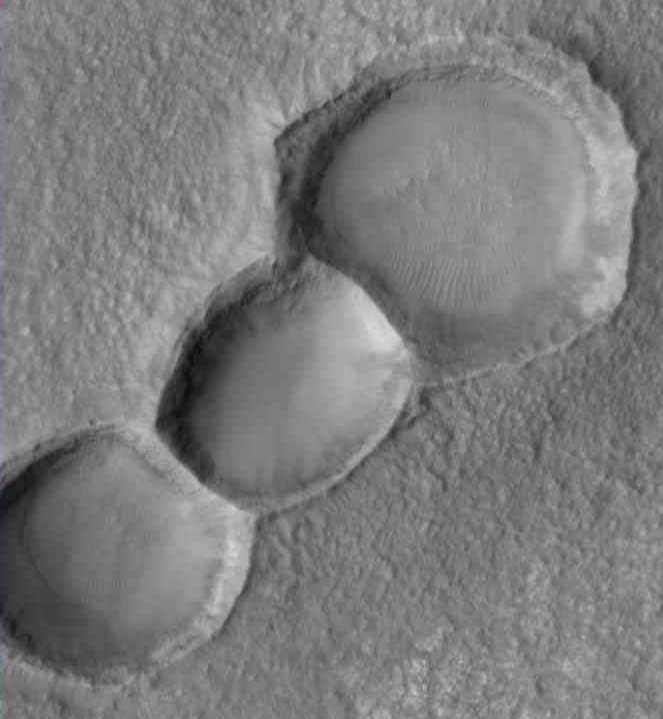- The First Law of Modern Astronomy is:
Thou shalt not ask questions that cast doubt on accepted theory.
-
- In the case of this image of craters on Mars, the accepted
theory is the impact origin of craters. The image is interpreted in light
of the theory, no questions asked, in the accompanying caption: "[T]hree
aligned meteor impact craters on the floor of a much larger crater in the
Noachis Terra region. The craters may have formed together from a single
event in which the impactor (the meteor) was broken into three pieces".
-
- A single event is required because there is no rubble
on the floors of the craters from the adjacent impacts. The blast forces
would have had to act simultaneously to displace laterally the ejecta situated
between the impacts. But the only imaginable way to get three craters in
a single event is to have the impactor break into three pieces. And then
the problem returns to the first observation of three aligned craters:
It is unlikely that a meteor breaking up under the forces of heat and shock
in the atmosphere will produce pieces that travel abreast to the surface.
The theory has bitten itself on the ankle and is hobbling around in a circle.
-
- Coincidences do happen. But if this explanation of simultaneity
is to have any generality beyond this one case, coincidence is stretched
to credulity in the many cases of chains of craters numbering far beyond
three. (See Crater
Chains)
-
- The Electric Universe asks if these aligned craters might
be better explained as electrical discharge scars. An electric arc impinging
on a surface will "machine" out a circular hole, much like a
router bit. The bottom will be fairly flat; the sides will be steep; the
removed material will be lifted away, leaving a clean excavation. Especially
with a moving electrode, the discharge channel will tend to "jump"
along the line of motion, leaving a linear series of craters. Because the
debris is lifted from the surface, subsequent craters will not throw debris
into previous ones. (See Craters
in the Lab)
-
- The arc will pull charges from the surrounding ground,
forming smaller channels that travel horizontally over or under the surface.
These will leave gullies, or "rilles", directed more or less
radially toward the crater. As these secondary currents reach the main
arc, they will rise to join it, leaving a triangular area beneath them
where the excavation forces are reduced. This will produce the characteristic
"pinched up" rims, steep on both inside and outside, with more
or less evenly spaced gullies traveling up them. After the arc quenches,
of course, gravity will cause any loose material that exceeds the "angle
of repose" to slide down.
-
- In view of the facts that 99% of the universe is composed
of plasma, that Mars is immersed in plasma, and that spacecraft have detected
electric currents in every plasma they have penetrated, astronomers need
to begin doubting the obsolete theories that were conceived before the
electrical properties of plasma were discovered.
-
- Photo Credit: NASA/JPL/Malin Space Science Systems
|

